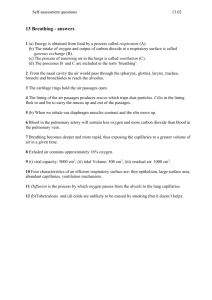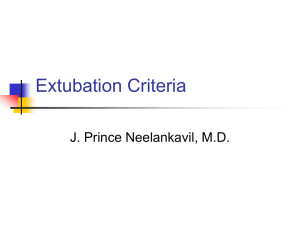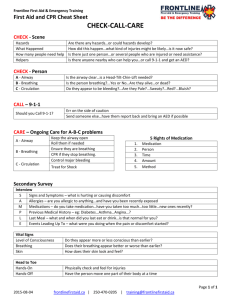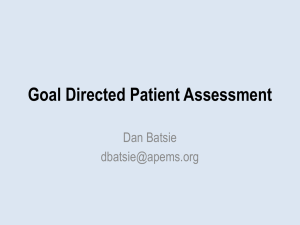Chapter 19
advertisement
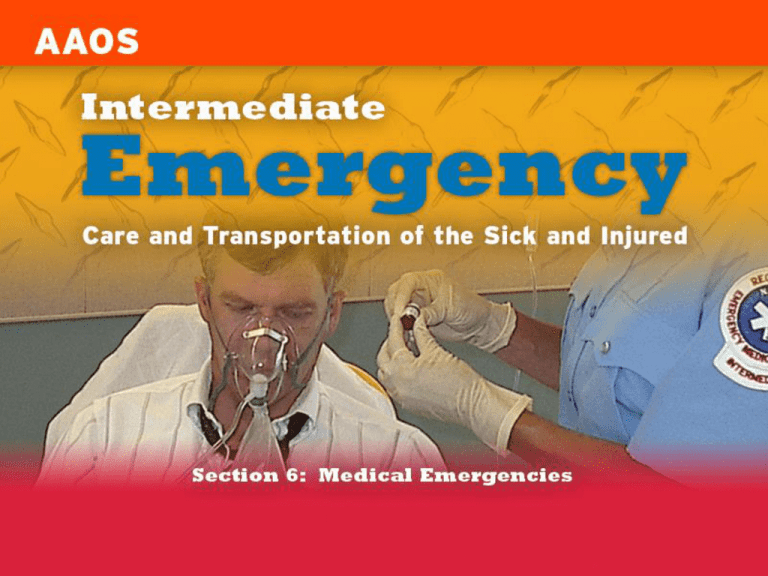
2 Chapter 19 Respiratory Emergencies 3 Objectives • There are no 1985 objectives for this chapter. 4 Respiratory Emergencies • Dyspnea – Difficulty breathing – Common chief complaint • COPD – Impedes normal functioning • Learn the signs and symptoms. • Feeling air-starved is frightening, no matter what the cause. 5 Anatomy and Function of the Lungs • Structures that contribute to breathing – Upper and lower airways – Lungs – Diaphragm • Path of air travel • Principle function of the lungs – Respiration • Diffusion 6 Lung Disorders • Pulmonary vessels are prevented from absorbing oxygen, and releasing carbon dioxide. • Alveoli are damaged. • Air passages are obstructed. • Blood flow to the lungs is obstructed. • Pleural space is filled with air or fluid. 7 Normal Respiratory Drive • Brainstem senses carbon dioxide levels in arterial blood. • Carbon dioxide level surrounding the brain stem is what stimulates breathing. • When the carbon dioxide levels are too low, rate and depth of breathing decrease, and vice versa. 8 Adequate Breathing • • • • • Normal rate and depth Regular pattern of inhalation and exhalation Good audible, bilateral breath sounds Equal, bilateral chest rise and fall Pink, warm, and dry skin 9 Inadequate Breathing • • • • • • • Rate that falls out of the range of 12-20 breaths/min Reduced flow of expired air Muscle retractions or pursed lips Diminished, noisy, or absent breath sounds Unequal chest wall movement Pale, cool, cyanotic skin Shallow, irregular respirations 10 Rising Levels of Carbon Dioxide • • • • Lung disorders Excessive carbon dioxide production Chronic carbon dioxide retention Hypoxic drive 11 Causes of Dyspnea (1 of 2) • • • • • • • Acute pulmonary edema Airway obstruction COPD Asthma or allergic reaction Rib fractures Spontaneous pneumothorax Upper or lower airway infections 12 Causes of Dyspnea (2 of 2) • • • • • • Pleural effusion Pulmonary thromboembolism Hyperventilation syndrome Prolonged seizures Use of CNS depressant drugs Neuromuscular disease 13 Upper or Lower Airway Infection • Some can cause mild discomfort, whereas others can be life threatening • Some form of obstruction – Flow of air – Exchange of gases • Diseases associated with dyspnea 14 Acute Pulmonary Edema • Two categories – High pressure – High permeability • Accumulation of fluids • Myocardial damage • Patients can present with: – Dyspnea/orthopnea – Fatigue/pulmonary rales 15 Management of Cardiogenic Pulmonary Edema • • • • • • Place in position of comfort. Assess the airway, provide oxygen. Establish IV access. Monitor flow rates to avoid fluid excess. Consider NTG. Transport to nearest appropriate facility. 16 Management of Noncardiogenic Pulmonary Edema • • • • • Place in position of comfort. Manage ABCs. Transport to the nearest appropriate facility. Remove patient from toxins/underlying problems. Provide reassurance. 17 Obstructive Airway Disease • Encompasses diseases that affect people worldwide – COPD – Asthma • Exacerbation of underlying conditions – Internal – External 18 Obstruction • Occurs in the bronchioles • May result from smooth muscle spasm or mucous production • May be reversible or irreversible • Caused by air trapping • Affects 10-20% of the U.S. population • Many causes; cigarette smoking most common 19 COPD • Chronic bronchitis – Constant, excess mucous production – Productive cough for at least 3 months/yr – “Blue bloaters” • Emphysema – Surfactant – Irreversible condition – “Pink puffers” 20 Commonalities of COPD Patients • • • • • • • • Sputum production Chronic cough Difficulty expelling air Long expiration times Wheezing Usually older than 50 years of age Hx of recurring lung problems Long-term cigarette smokers 21 Abnormal Breath Sounds • Rales – Fine, crackling sounds – Chronic scarring of small airways • Rhonchi – Coarse rattling sounds – Mucous in large airways • Wheezing – Whistling sounds – Heard on expiration 22 Common Complaints/Hx/Signs • • • • • • Chest tightness Fatigue Recent “chest cold” Normal BP Rapid, sometimes irregular pulse Respirations either rapid or slow 23 Asthma • • • • • Affects 6 million Americans Kills 4,000-5,000 people yearly “Audible wheezing” or no sounds Reversible condition Common causes – Allergic reaction – Exercise or stress – Upper respiratory infection 24 Assessment Findings • Signs of respiratory impairment – Inability to speak freely • Common chief complaints – Dyspnea, cough, nocturnal dyspnea • Obtain thorough history • Determine possibility of acute exposure • Other common signs – Retractions 25 Management of Asthma • • • • • Place in position of comfort. Monitor the airway. Provide high-flow oxygen. Initiate IV access. Assist with MDI. 26 Anaphylaxis • Characterized by: – Airway swelling – Dilation of blood vessels • Can significantly lower BP • Can be associated with itching and asthma-like condition • Most occur within 30 minutes of exposure • Oxygen, epinephrine, antihistamines 27 Hay Fever • Caused by allergic reaction to substances such as pollen, molds, and grasses • Generally does not produce major emergency problems • Signs are a stuffy/runny nose and sneezing 28 Spontaneous Pneumothorax • • • • • • Vacuum pressure in the pleural space Accumulation of air in the pleural space Caused by medical conditions Pleuritic chest pain Subcutaneous emphysema Some severe findings: – Altered mental status – Cyanosis 29 Management of Spontaneous Pneumothorax • • • • • • Monitor ABCs. Provide high-flow oxygen. Watch for signs of tension pneumothorax. Initiate IV access. Place patient in a position of comfort. Call ALS if needed. 30 Pneumonia • • • • Infection of lung parenchyma Most commonly bacterial Fifth leading cause of death in the U.S. Risk factors – Cigarette smoking – Alcoholism – Exposure to the cold – Very young or old 31 Management of Pneumonia • • • • • ABCs Ventilatory support PRN High-flow oxygen IV fluids Cool if high fever present 32 Pleural Effusion (1 of 2) • Cause dyspnea. • Response to irritation, infection, or cancer. • Should be considered a possibility in lung patients with SOB. • Decreased lung sounds where fluid has moved the lung away from the chest wall. • Most patients feel better sitting upright. • Fluid must be removed by a physician. 33 Pleural Effusion (2 of 2) 34 Mechanical Airway Obstruction • Semi- and unconscious patients can have an obstruction as the result of a foreign body or the tongue. • Always consider upper airway obstruction from a foreign object first in patients who were just eating. • Can be the result of trauma, edema, mucous accumulation, or muscle spasm. 35 Pulmonary Thromboembolism • Embolus – anything that obstructs distal blood flow • May occur from damage to the lining of the vessels, tendency of blood to clot fast, or blood flow in a lower extremity • Some risk factors – Bedridden patients, prolonged inactivity, recent surgery, and oral contraceptives 36 Signs and Symptoms • • • • • • • Acute dyspnea/pleuritic chest pain Hemoptysis Cyanosis Tachypnea Varying degrees of hypoxia Tachycardia Normal breath sounds or wheezing 37 Management of Pulmonary Thromboembolism • • • • • • Provide high-flow oxygen. Assist with ventilations PRN. Initiate CPR PRN. Initiate IV access. Give fluid for hydration based on clinical symptoms. Transport to nearest appropriate facility. 38 Hyperventilation Syndrome • Defined as overbreathing to the point at which the level of arterial carbon dioxide falls below normal. • Most common physical findings: – Rapid breathing with high minute volume – Carpopedal spasms • Diagnosis should occur in hospital. 39 Management of Hyperventilation Syndrome • • • • Provide psychological support. Have the patient mime your breathing. Never withhold oxygen. Rate of oxygen is based on symptoms and pulse oximetry readings. • Never use a paper bag. • Transport to closest facility. 40 Emergency Care of Respiratory Emergencies • • • • • • Pay attention to respirations while gathering vital signs. Administer oxygen. Provide reassurance. Reassess the patient every 5 minutes. Never withhold oxygen. Assist breathing via BVM if necessary. 41 Scene Size-Up and Initial Assessment • Assure safe environment. • Recognize and treat life threats. • Some signs of life-threatening respiratory distress – Altered mental status – Absent breath sounds – 1- to 2-word dyspnea – Tachycardia 42 Approach to the Patient in Respiratory Distress • Obtain a general impression • Signs and symptoms – Determine whether breathing is adequate • Focused history and physical exam – C/C – OPQRST – Vital signs – Determine respiratory pattern 43 Management • • • • • • • Provide high-flow oxygen. Ensure a patent airway. Provide positive pressure ventilation PRN. Consider a dual-lumen airway. Obtain vital signs and a SAMPLE history. Assist with MDI. Use IV and cardiac monitor. 44 Prescribed Inhalers • • • • Inhaled beta agonists Selective beta-2 receptors in the lungs Albuterol, metaproterenol, terbutaline Common side effects – Tachycardia – Nervousness – Muscle tremors • Ensure no contraindications prior to administration 45 Administration of MDIs • • • • • • • • Obtain an order. Check the “6 rights.” Shake MDI vigorously. Provide instructions if needed. Apply spacer if one’s available. Replace oxygen after administration. Repeat per protocol. Reassess during transport.

